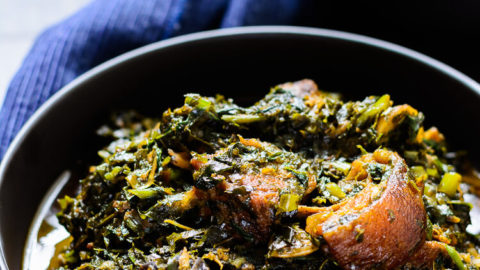- 您的话题内容不能为空。
- 作者帖子
- 28 3 月, 2025 2:12 下午 #611485

Afang leaf (Gnetum africanum) holds a prominent place in Nigerian cuisine, celebrated for its unique flavor and nutritional value, particularly in regions like Abuja, Federal Capital Territory, Nigeria, where it is a popular vegetable.
Exploring Afang leaf in Nigerian cuisine: regional variations and culinary significance reveals its integral role in traditional meals, its adaptation across different ethnic groups, and its economic importance as a food commodity.
This article will delve into the diverse culinary applications of Afang leaf and its cultural significance within Nigeria.
1. The Iconic Afang Soup: Preparation And Basic Ingredients
The most well-known dish featuring Afang leaf is undoubtedly Afang soup, a rich and flavorful soup popular, especially among the Efik and Ibibio people of Cross River and Akwa Ibom states.
The basic preparation of Afang soup involves combining the finely chopped Afang leaves with palm oil, meat (such as beef, goat meat, or assorted meat), crayfish, and often other vegetables like waterleaf. Onions, peppers, and seasonings like bouillon cubes are also key ingredients.
While the core elements remain consistent, variations exist in the types of meat used, the inclusion of other vegetables, and the specific spice combinations, showcasing the adaptability of Afang soup within Nigerian cuisine.
2. Regional Adaptations And Variations Of Afang Soup
While originating in the South-South region, Afang soup has gained popularity across Nigeria, leading to regional adaptations. In some areas, different types of protein might be favored, such as smoked fish or chicken. The consistency of the soup can also vary, with some regions preferring a thicker version while others enjoy it with more liquid.
The use of spices and peppers can also differ, reflecting local taste preferences. Even within the South-South, families might have their own unique twists on the recipe, passed down through generations. These regional variations highlight the culinary significance and adaptability of Afang leaf within Nigerian cuisine.
3. Beyond Soup: Other Culinary Uses Of Afang Leaf
While Afang soup is the most famous application, Afang leaf is also used in other Nigerian dishes. It can be added to stews and sauces, contributing its distinct flavor and nutritional value. In some regions, it is used as a vegetable in its own right, perhaps lightly steamed or sautéed with other ingredients.
The leaves can also be incorporated into omelets or used to wrap other food items. These diverse uses demonstrate the culinary versatility of Afang leaf beyond its role in the popular soup, further emphasizing its importance in Nigerian cuisine.
4. Cultural Significance In Nigerian Society
Afang leaf holds cultural significance in Nigerian society, particularly among the Efik and Ibibio people, where Afang soup is often served at important ceremonies and gatherings, such as weddings, funerals, and festivals.
The preparation and sharing of Afang soup can be a communal activity, strengthening social bonds. The dish is often seen as a symbol of hospitality and celebration. Its presence at these events underscores the cultural importance of Afang leaf and its role in traditional meals and social interactions within Nigeria.
5. Economic Importance As A Food Commodity
The popularity of Afang leaf in Nigerian cuisine has contributed to its economic importance as a food commodity. It is widely cultivated and sold in markets across the country, including major markets in Abuja, Federal Capital Territory, Nigeria.
The trade in Afang leaves provides livelihoods for many people involved in its cultivation, harvesting, transportation, and sale. The demand for Afang leaf, driven by dishes like Afang soup, supports local agriculture and contributes to the economy, highlighting the economic significance of this vegetable within Nigeria.
In conclusion, Afang leaf is a vital ingredient in Nigerian cuisine, most notably in the iconic Afang soup, which boasts regional variations and cultural significance. However, its culinary uses extend beyond this popular dish, with the leaf being incorporated into stews, sauces, and other meals.
Its presence at cultural events underscores its importance in Nigerian society, and its economic value as a food commodity is substantial.
Understanding Afang leaf in Nigerian cuisine: regional variations and culinary significance provides insight into the rich culinary heritage of Nigeria and the important role this nutritious vegetable plays in both traditional meals and the national economy.
Read Also:Afang Leaf In Nigerian Cuisine: Regional Variations And Culinary Significance
- 作者帖子
- 哎呀,回复话题必需登录。

